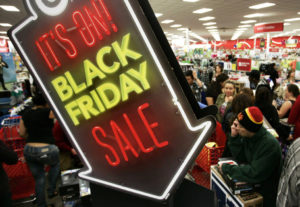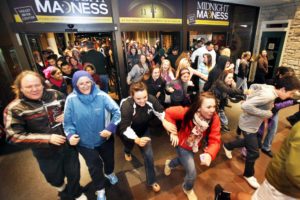As November comes to a close, people are getting excited about what they have to look forward to in the coming month. Thanksgiving is quickly approaching, which means that Hanukkah and Christmas are right around the corner. Although the holidays are an exciting time for most, businesses are even more excited about the influx of cash they are going to make. Black Friday, the Friday after Thanksgiving, is one of the most important retail days of the year for most businesses, with around 30% of annual retail sales occurring between Black Friday and Christmas. Therefore, it is important for businesses to strategically plan how they are going to approach the Black Friday holiday in order to maximize sales and further stimulate the economy.
In the U.S., Black Friday has been regarded as the beginning of the Christmas shopping season since 1932. It is referred to as  Black Friday because many retailers usually make enough sales on that day to put them in the black for the year, meaning that they will begin to turn a profit. In 2015, 74.2 million people shopped on Black Friday alone, which is lower than the number in past years ranging anywhere from 85 million in 2011 to 92 million in 2013. Although the number of consumers have decreased in recent years, 74.2 million shoppers still means large profits for these corporations.
Black Friday because many retailers usually make enough sales on that day to put them in the black for the year, meaning that they will begin to turn a profit. In 2015, 74.2 million people shopped on Black Friday alone, which is lower than the number in past years ranging anywhere from 85 million in 2011 to 92 million in 2013. Although the number of consumers have decreased in recent years, 74.2 million shoppers still means large profits for these corporations.
Black Friday is known for kicking off holiday spending, however, the three-day Black Friday weekend is where businesses truly make their money. In 2014, 133.7 million people shopped over the weekend. Each one of these 133 million spent, on average, $380.95, which totals out to be around $51 billion dollars of consumer money that was poured into the economy. Investors examine Black Friday sales in order to examine the health of the retail industry. Since many economists believe that spending drives economic growth and activity, they will imply that if Black Friday spending is low the health of the economy is too.
As investors analyze the signals that Black Friday has on the direction of the market for the rest of the year, they tend to tailor their trades to reflect what they believe will be the future of Black Friday sales for that year. Whether the retail performance on Black Friday is good or bad, the results signal consumer confidence in the economy. According to research conducted by the National Retail Federation, 2016 holiday sales have the potential to increase by 3.6% and shoppers plan to spend approximately $655.8 billion.
To prepare for the three busiest retail days of the year, businesses are rearranging their stores, stocking up on merchandise, and hiring between 640,000 and 690,000 workers nationwide. This planning is necessary in order to compete with big-box retailers, like Wal-Mart, who brings in around $8.4 billion on Black Friday. Not only do this week’s upcoming sales have a powerful effect on the future of many businesses but more importantly, the sales should be thoroughly analyzed because the results are an accurate indicator of the health of our nation’s economy.
Sources:
https://www.thebalance.com/what-is-black-friday-3305710
http://www.tradingacademy.com/lessons/article/does-black-friday-have-an-impact-on-the-stock-market/



Leave a Reply
You must be logged in to post a comment.